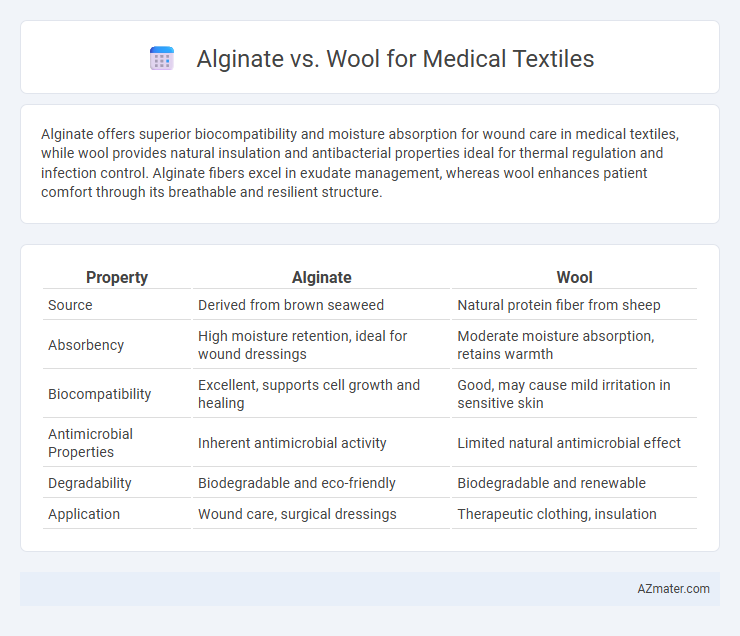Alginate offers superior biocompatibility and moisture absorption for wound care in medical textiles, while wool provides natural insulation and antibacterial properties ideal for thermal regulation and infection control. Alginate fibers excel in exudate management, whereas wool enhances patient comfort through its breathable and resilient structure.
Table of Comparison
| Property | Alginate | Wool |
|---|---|---|
| Source | Derived from brown seaweed | Natural protein fiber from sheep |
| Absorbency | High moisture retention, ideal for wound dressings | Moderate moisture absorption, retains warmth |
| Biocompatibility | Excellent, supports cell growth and healing | Good, may cause mild irritation in sensitive skin |
| Antimicrobial Properties | Inherent antimicrobial activity | Limited natural antimicrobial effect |
| Degradability | Biodegradable and eco-friendly | Biodegradable and renewable |
| Application | Wound care, surgical dressings | Therapeutic clothing, insulation |
Introduction to Medical Textiles
Medical textiles incorporate specialized materials like alginate and wool, each offering unique properties essential for healthcare applications. Alginate fibers, derived from seaweed, provide excellent biocompatibility, moisture absorption, and wound healing capabilities, making them ideal for dressings and scaffolds. Wool, known for its natural elasticity, thermal regulation, and comfort, is utilized in compression garments and prosthetic liners, enhancing patient comfort and recovery.
Overview of Alginate Fibers
Alginate fibers are derived from seaweed and possess exceptional biocompatibility, biodegradability, and high absorbency, making them ideal for medical textiles such as wound dressings and surgical pads. Unlike wool, alginate fibers exhibit superior moisture management and promote a moist wound environment, accelerating healing while preventing infection. Their natural gel-forming ability upon contact with wound exudate distinguishes alginate fibers as highly effective in advanced wound care applications.
Overview of Wool Fibers
Wool fibers exhibit natural crimp, elasticity, and excellent moisture-wicking properties, making them advantageous for medical textiles requiring comfort and breathability. Their inherent antimicrobial and hypoallergenic characteristics support wound healing and reduce infection risks. Unlike alginate fibers derived from seaweed, wool offers enhanced durability and thermal regulation in medical applications.
Key Properties of Alginate in Wound Care
Alginate fibers in medical textiles exhibit exceptional absorbency, capable of holding up to 20 times their weight in fluid, making them ideal for managing exuding wounds. Their biocompatibility and hemostatic properties promote natural clotting and aid in faster wound healing. Unlike wool, alginate is biodegradable, non-allergenic, and provides a moist wound environment critical for tissue regeneration.
Key Properties of Wool in Wound Care
Wool in medical textiles offers superior moisture management due to its natural hygroscopic properties, effectively maintaining a balanced wound environment that promotes healing. Its inherent elasticity and resilience provide cushioning and pressure relief, reducing the risk of further tissue damage. Additionally, wool's antimicrobial characteristics help minimize infection risks, making it a valuable material in advanced wound care applications.
Biocompatibility and Safety Comparison
Alginate fibers exhibit superior biocompatibility and safety in medical textiles due to their natural origin, hypoallergenic properties, and excellent moisture absorption, promoting faster wound healing with minimal irritation. Wool, while natural and breathable, may cause allergic reactions and skin irritation in sensitive patients, limiting its suitability for direct wound contact applications. Alginate's ability to create a moist environment and its non-toxic degradation products make it a safer choice for wound dressings compared to wool-based materials.
Absorption Capacity and Moisture Management
Alginate fibers exhibit superior absorption capacity compared to wool, with the ability to absorb up to 20 times their weight in fluids, making them highly effective for wound dressings in medical textiles. Wool, while naturally hygroscopic, retains moisture close to the skin and offers moderate moisture management but lacks the rapid fluid uptake characteristic of alginate. The unique polysaccharide structure of alginate enables faster moisture wicking and enhanced fluid retention, crucial for maintaining an optimal healing environment.
Antimicrobial Performance
Alginate fibers exhibit superior antimicrobial performance in medical textiles due to their natural biocompatibility and ability to maintain a moist wound environment, which inhibits bacterial growth. Wool, while inherently antimicrobial because of its lanolin content and moisture-wicking properties, shows less consistent antimicrobial efficacy compared to alginate-based materials. The enhanced antimicrobial activity of alginate makes it a preferred choice for wound care applications requiring infection control and accelerated healing.
Sustainability and Environmental Impact
Alginate fibers, derived from brown seaweed, offer superior biodegradability and renewable sourcing compared to wool, which relies on animal agriculture with higher water and land use. The production of alginate involves minimal chemical processing, reducing ecological footprint, whereas wool processing can contribute to methane emissions and pesticide use in sheep farming. Alginate's marine-based origin and rapid decomposition make it a more sustainable choice for medical textiles focused on minimizing environmental impact.
Choosing Between Alginate and Wool for Medical Applications
Choosing between alginate and wool for medical textiles hinges on their distinct properties; alginate excels in moisture absorption and biocompatibility, making it ideal for wound dressings that require effective exudate management and promoting healing. Wool offers natural insulation and cushioning, beneficial for padding and temperature-regulating applications, but may lack the superior absorbency and biodegradability of alginate fibers in clinical environments. Careful consideration of wound type, moisture level, and patient sensitivity is crucial to select the most appropriate material for optimized medical textile performance.

Infographic: Alginate vs Wool for Medical textile
 azmater.com
azmater.com